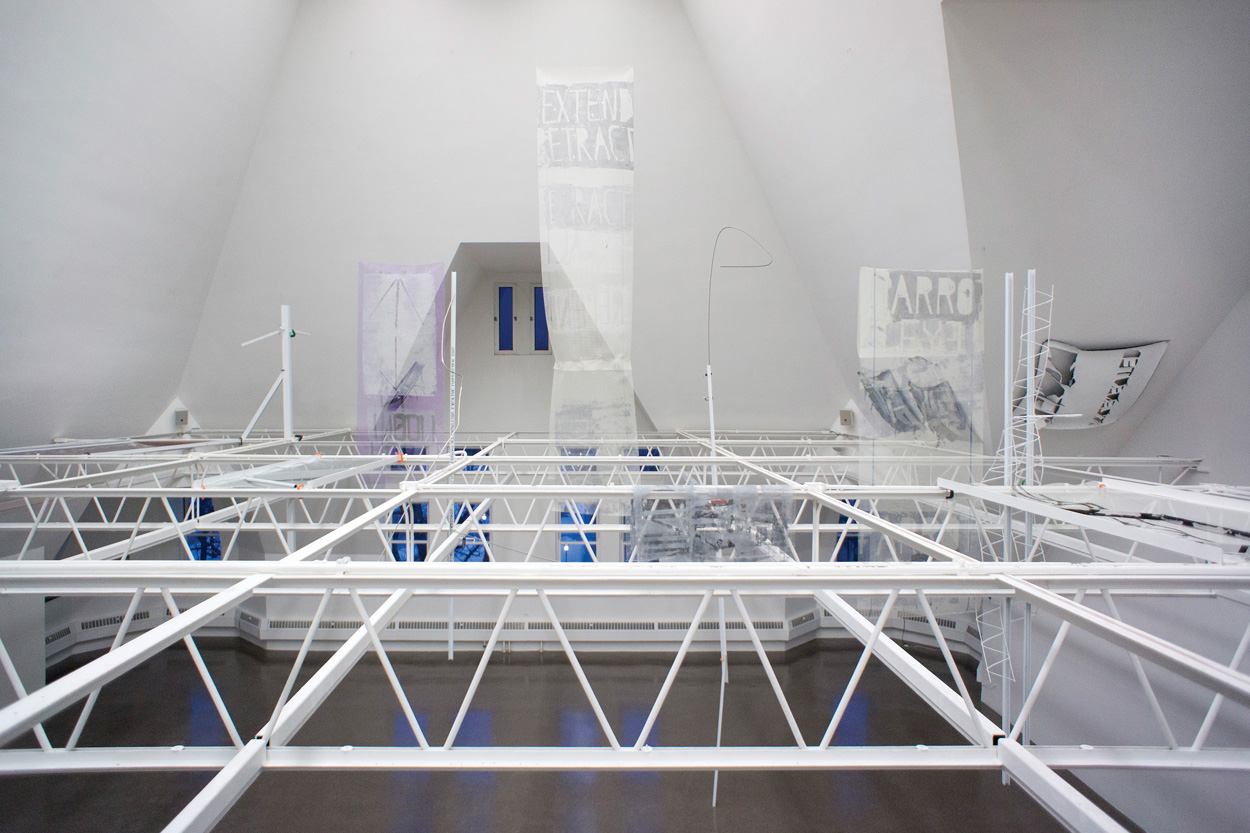
Nora Schultz describes her exhibition “Parrottree—Building for Bigger than Real” as being about “superstructure,” the set of dominant principles, beliefs, or ideas that arise from more fundamental realities. As she said at a talk during the show’s opening reception, “Parrottree” is “struggling with being under pressure of any kind of superstructure. I am trying to deal with it, trying to hack the system.”
Schultz’s work invokes the physical notion of a superstructure: most of her pieces hang from the elaborate metal framework that spans the length of the Renaissance Society’s ceiling, and viewers must crane their necks to examine the suspended objects. Most of them are large pieces of cardboard, metal mesh, and weathered, paint-flecked wood. Some are blank, and others are inscribed with crudely hewn phrases such as “extend retract,” “parrot eye,” and “am I a machine dreaming I am a mind or am I a mind dreaming.”
Her work also heavily references avian life, particularly Hyde Park’s itinerant parrot colony and the peregrine falcon. Recorded parrot calls echo through the room, and in one corner a window—with glass panel intact—is propped up horizontally on four wooden stilts. The accompanying plaque denotes it as the former structure behind which a peregrine falcon made its nest.
Schultz brings these items out of their normal contexts in part to illuminate the artistry of creation. By displaying objects that are traditionally viewed as materials for creation—like planks of wood and sheets of metal mesh—as completed installations, Schultz exalts in the artistic process rather than the product.
She also uproots these objects in order to break own their superstructure—that is, the meaning they derive from their original, elemental functions. By removing the window from the context of the peregrine falcon’s home, she dissolves its invented significance as a place of refuge for a bird. Schultz leaves it up to her viewers to create their own superstructure for this object as it exists within the context of the gallery.
The Hyde Park parrots embody such superstructural upheaval. The parrots, native to South America, mysteriously appeared in Hyde Park in the early 1970s and have since thrived despite the inclement weather. They reinvented Chicago’s unforgiving urban landscape by making it their home, imbuing windowsills, trees, and buildings with new and unexpected meaning.
Schultz’s work challenges traditional conceptions of superstructure by playing with the context of everyday objects; unfortunately, however, the works’ concepts also function as a crutch. Schultz’s most complex conceptual pieces are also her least interesting works of art. Perhaps Schultz believes that the intricate ideological framework underlying her efforts absolves her of any responsibility to create aesthetically interesting pieces.
Schultz’s work provides little physical evidence for the ideas it attempts to convey. One prominently featured piece is a newspaper clipping that describes the latest technological gadgets. Circled in black pen are pictures of an exercise-tracking smartphone app and a camera-carrying drone. This piece seems only tangentially connected to the larger theme of the show in that it details a camera capable of providing a “birds-eye view,” and relates to the show’s recurring avian imagery. Beyond this tenuous connection, however, the piece is neither conceptually relevant nor visually stimulating. The rest of the exhibit is similarly opaque. To a casual viewer, the sparse arrangement of industrial materials and slabs of wood would surely be incomprehensible.
The exhibition, by presenting an unconventional collection of objects and labeling them as art, attempts to break free from the prevailing art-world superstructure, which sets the standard for what art is supposed to be. Schultz’s attempt, however, demonstrates that success does not necessarily result from transgression.
The Renaissance Society, 5811 S. Ellis Ave., fourth floor. Through February 23. Tuesday-Friday, 10am-5pm; Saturday-Sunday, noon-5pm. Free. (773)702-8670. renaissancesoci
